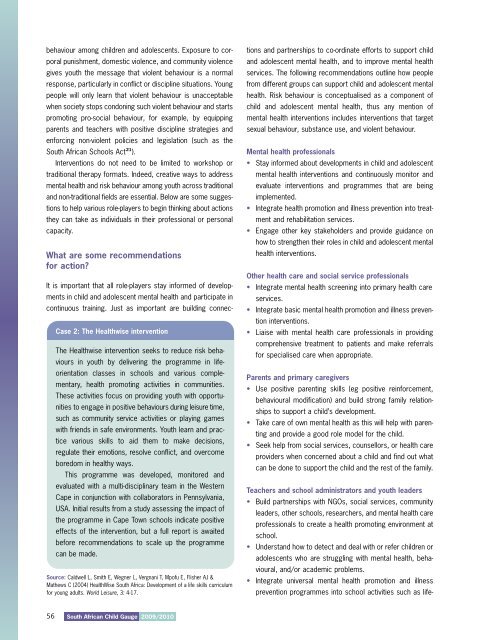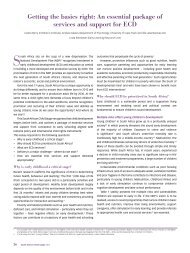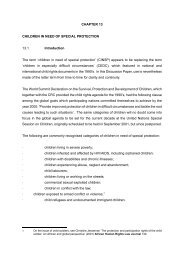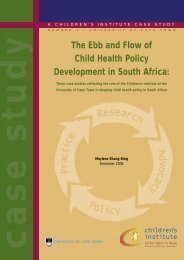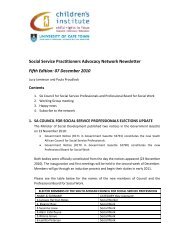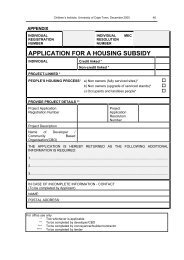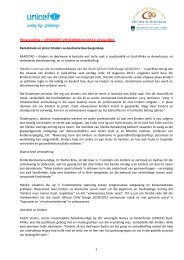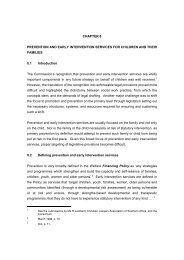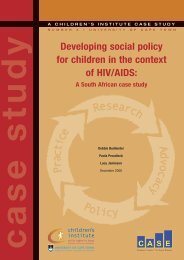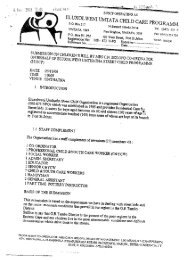Mental health and risk behaviour
Mental health and risk behaviour
Mental health and risk behaviour
You also want an ePaper? Increase the reach of your titles
YUMPU automatically turns print PDFs into web optimized ePapers that Google loves.
ehaviour among children <strong>and</strong> adolescents. Exposure to corporal<br />
punishment, domestic violence, <strong>and</strong> community violence<br />
gives youth the message that violent <strong>behaviour</strong> is a normal<br />
response, particularly in conflict or discipline situations. Young<br />
people will only learn that violent <strong>behaviour</strong> is unacceptable<br />
when society stops condoning such violent <strong>behaviour</strong> <strong>and</strong> starts<br />
promoting pro-social <strong>behaviour</strong>, for example, by equipping<br />
parents <strong>and</strong> teachers with positive discipline strategies <strong>and</strong><br />
enforcing non-violent policies <strong>and</strong> legislation (such as the<br />
South African Schools Act 21 ).<br />
Interventions do not need to be limited to workshop or<br />
traditional therapy formats. Indeed, creative ways to address<br />
mental <strong>health</strong> <strong>and</strong> <strong>risk</strong> <strong>behaviour</strong> among youth across traditional<br />
<strong>and</strong> non-traditional fields are essential. Below are some suggestions<br />
to help various role-players to begin thinking about actions<br />
they can take as individuals in their professional or personal<br />
capacity.<br />
What are some recommendations<br />
for action?<br />
Case 2: The Healthwise intervention<br />
The Healthwise intervention seeks to reduce <strong>risk</strong> <strong>behaviour</strong>s<br />
in youth by delivering the programme in lifeorientation<br />
classes in schools <strong>and</strong> various complementary,<br />
<strong>health</strong> promoting activities in communities.<br />
These activities focus on providing youth with opportunities<br />
to engage in positive <strong>behaviour</strong>s during leisure time,<br />
such as community service activities or playing games<br />
with friends in safe environments. Youth learn <strong>and</strong> practice<br />
various skills to aid them to make decisions,<br />
regulate their emotions, resolve conflict, <strong>and</strong> overcome<br />
boredom in <strong>health</strong>y ways.<br />
This programme was developed, monitored <strong>and</strong><br />
evaluated with a multi-disciplinary team in the Western<br />
Cape in conjunction with collaborators in Pennsylvania,<br />
USA. Initial results from a study assessing the impact of<br />
the programme in Cape Town schools indicate positive<br />
effects of the intervention, but a full report is awaited<br />
before recommendations to scale up the programme<br />
can be made.<br />
Source: Caldwell L, Smith E, Wegner L, Vergnani T, Mpofu E, Flisher AJ &<br />
Mathews C (2004) HealthWise South Africa: Development of a life skills curriculum<br />
for young adults. World Leisure, 3: 4-17.<br />
It is important that all role-players stay informed of developments<br />
in child <strong>and</strong> adolescent mental <strong>health</strong> <strong>and</strong> participate in<br />
continuous training. Just as important are building connections<br />
<strong>and</strong> partnerships to co-ordinate efforts to support child<br />
<strong>and</strong> adolescent mental <strong>health</strong>, <strong>and</strong> to improve mental <strong>health</strong><br />
services. The following recommendations outline how people<br />
from different groups can support child <strong>and</strong> adolescent mental<br />
<strong>health</strong>. Risk <strong>behaviour</strong> is conceptualised as a component of<br />
child <strong>and</strong> adolescent mental <strong>health</strong>, thus any mention of<br />
mental <strong>health</strong> interventions includes interventions that target<br />
sexual <strong>behaviour</strong>, substance use, <strong>and</strong> violent <strong>behaviour</strong>.<br />
<strong>Mental</strong> <strong>health</strong> professionals<br />
• Stay informed about developments in child <strong>and</strong> adolescent<br />
mental <strong>health</strong> interventions <strong>and</strong> continuously monitor <strong>and</strong><br />
evaluate interventions <strong>and</strong> programmes that are being<br />
implemented.<br />
• Integrate <strong>health</strong> promotion <strong>and</strong> illness prevention into treatment<br />
<strong>and</strong> rehabilitation services.<br />
• Engage other key stakeholders <strong>and</strong> provide guidance on<br />
how to strengthen their roles in child <strong>and</strong> adolescent mental<br />
<strong>health</strong> interventions.<br />
Other <strong>health</strong> care <strong>and</strong> social service professionals<br />
• Integrate mental <strong>health</strong> screening into primary <strong>health</strong> care<br />
services.<br />
• Integrate basic mental <strong>health</strong> promotion <strong>and</strong> illness prevention<br />
interventions.<br />
• Liaise with mental <strong>health</strong> care professionals in providing<br />
comprehensive treatment to patients <strong>and</strong> make referrals<br />
for specialised care when appropriate.<br />
Parents <strong>and</strong> primary caregivers<br />
• Use positive parenting skills (eg positive reinforcement,<br />
<strong>behaviour</strong>al modification) <strong>and</strong> build strong family relationships<br />
to support a child’s development.<br />
• Take care of own mental <strong>health</strong> as this will help with parenting<br />
<strong>and</strong> provide a good role model for the child.<br />
• Seek help from social services, counsellors, or <strong>health</strong> care<br />
providers when concerned about a child <strong>and</strong> find out what<br />
can be done to support the child <strong>and</strong> the rest of the family.<br />
Teachers <strong>and</strong> school administrators <strong>and</strong> youth leaders<br />
• Build partnerships with NGOs, social services, community<br />
leaders, other schools, researchers, <strong>and</strong> mental <strong>health</strong> care<br />
professionals to create a <strong>health</strong> promoting environment at<br />
school.<br />
• Underst<strong>and</strong> how to detect <strong>and</strong> deal with or refer children or<br />
adolescents who are struggling with mental <strong>health</strong>, <strong>behaviour</strong>al,<br />
<strong>and</strong>/or academic problems.<br />
• Integrate universal mental <strong>health</strong> promotion <strong>and</strong> illness<br />
prevention programmes into school activities such as life-<br />
56<br />
South African Child Gauge 2009/2010


